Sesame noodles is a perfect dish for a hot summer night when you don’t feel like standing in front of a hot stove. The nutty savory sauce that has a hint of sweetness and spiciness, it’s always a crowd pleaser. You can simply serve it without any toppings as a side dish. You top it with fresh summer produce and serve it as an appetizer for your grilling party. Or you can load it up with more toppings to serve it as a main. {Vegan, Vegetarian}
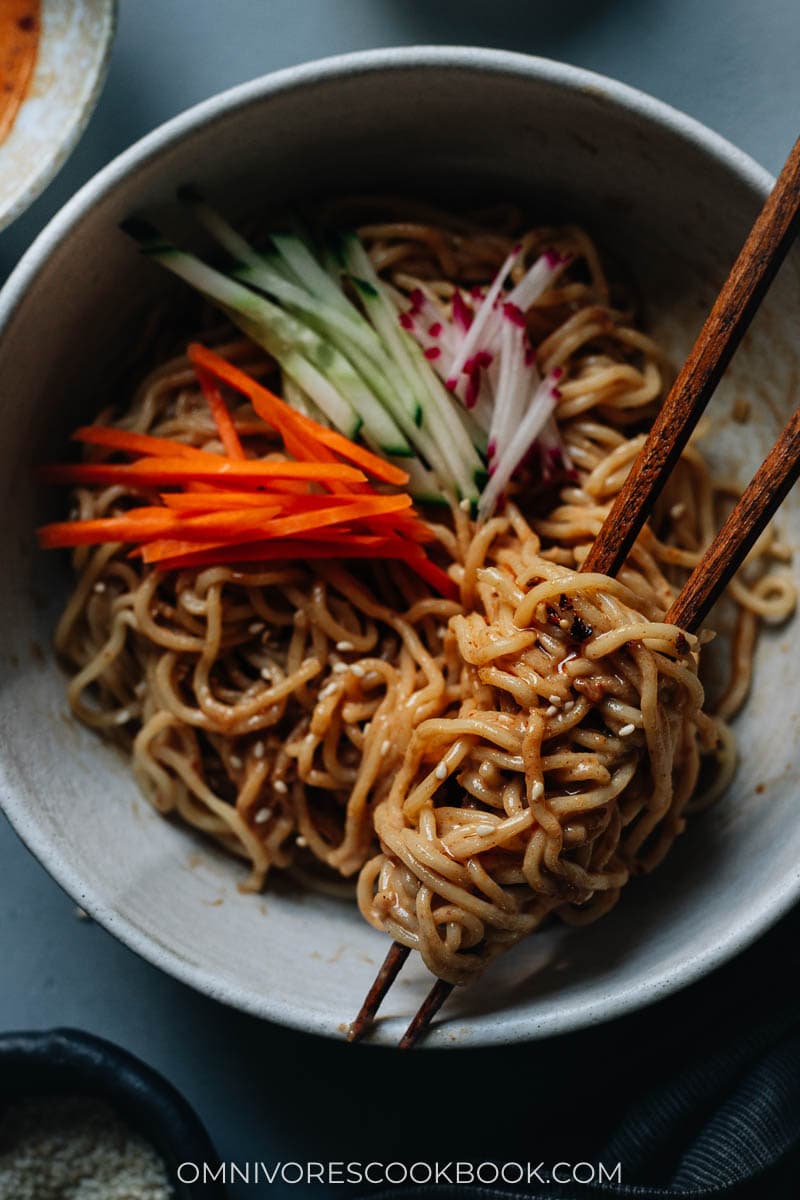
Sesame Noodles: A Symphony of Flavor
Sometimes I hear complaints that Chinese recipes tend to have super long ingredient lists, which scare people away. I couldn’t agree more. The fact is that Chinese cuisine is really good at playing with flavors. It brings together herbs, fermented sauces, and many ingredients that are sweet, salty, sour, and nutty to play a symphony. The tones and rhythms all come together, to create a beautiful melody. Everything is balanced, without a single ingredient jumping out or screaming loudly.
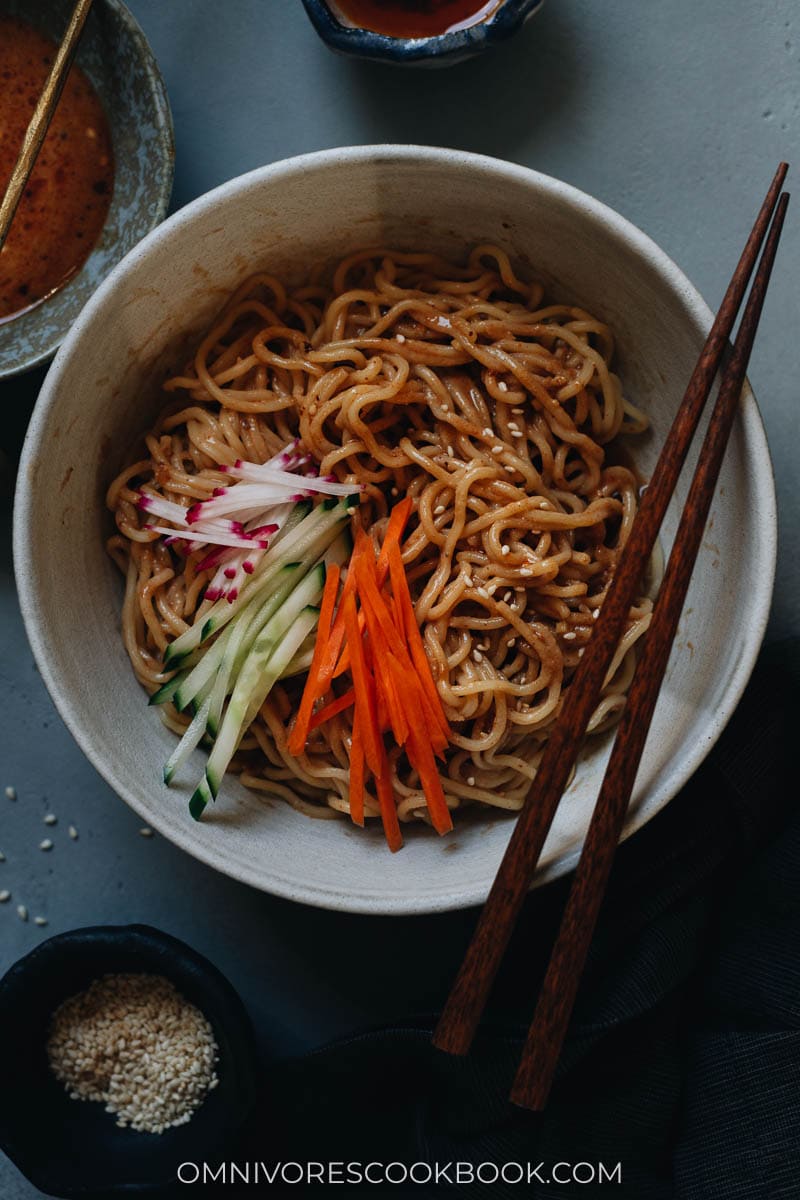
A Lot of Ingredients, Very Easy to Make
For “poor folks’ food” like noodles, the idea is to use the cheapest ingredients to maximize flavor. The goal is to make you happy with a stomach full of noodles, vegetables, and a minimal amount of meat (or no meat at all). A simple sesame noodle dish requires more than 10 ingredients to achieve this goal. In fact, if you count the ingredients needed to make the chili oil, you’ll need about 20 in total.
Sometimes I try to simplify recipes as much as I can, so you can actually make them at home. But in this case, I’d say you need the whole set of ingredients if you want the sauce to be interesting and not just taste like peanut butter.
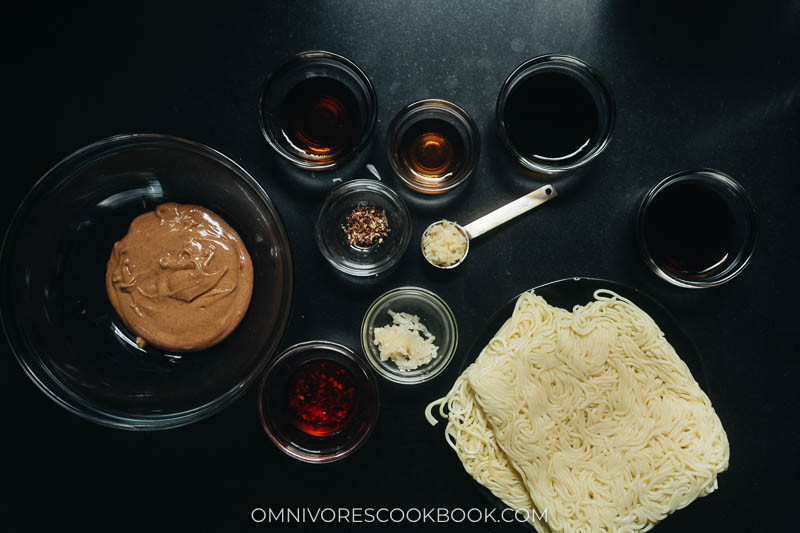
The Sesame Noodle Sauce isn’t Just for Noodles!
The flip side is that you can make more sauce ahead of time, store it in the fridge, and serve it during the week. For example,
- This sauce makes a very nice vegetable dip.
- It is also a great sauce for zucchini noodles.
- You can use it on roast chicken or leftover meat to make it more interesting.
- And you can thin it out a bit with water and use it as a salad dressing.
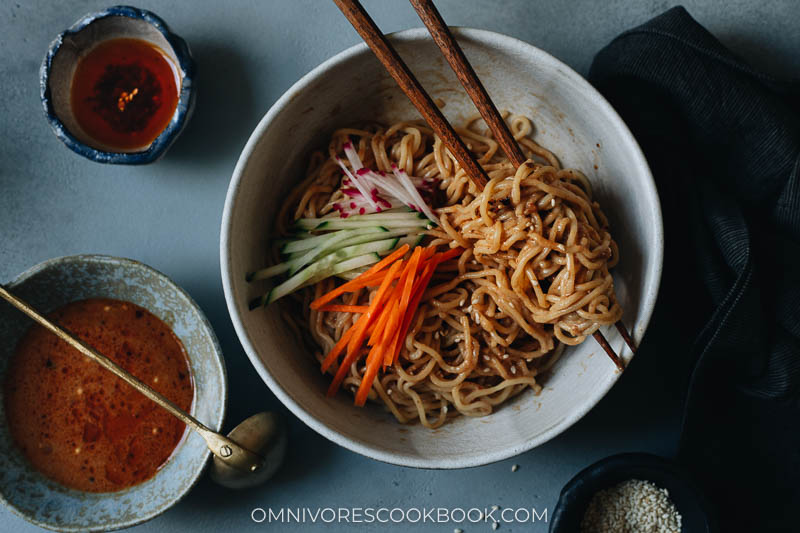
Make Your Own Chili Oil if You Can
The secret ingredients in this recipe are the homemade chili oil and roasted Sichuan peppercorn powder. When I serve this dish at cooking classes and events, I always sneak these two in there so that the noodles will wow everyone. With these ingredients, you can turn “just your average sesame noodles” into “OMG this is so good”.
How to Serve Sesame Noodles
You can serve sesame noodles either as an appetizer or a main dish. They are easy to prepare ahead of time and the sauce only gets better after it has been in the fridge a few hours. I might skip (or use very minimal) toppings on the noodles to keep them simple as an appetizer. On the other hand, you can add other things to make it a full meal. For example, leftover shredded meat, sliced avocado, eggs (boiled, poached, or fried), and more vegetables. In this case, make more sauce accordingly.
Better Too Much Sauce Than Too Little
The last thing I want to emphasize is to always make more sauce than you expect you’ll need. The problem with noodle salad is that you never get the exact amount of sauce correct. Every type and brand of noodles absorbs water and sauce in a different rate. Plus, you might want a bit of extra sauce on the side. The sauce in this recipe is plenty for two big servings or four small servings. But you won’t regret making a double batch in any case.
I hope you enjoy!
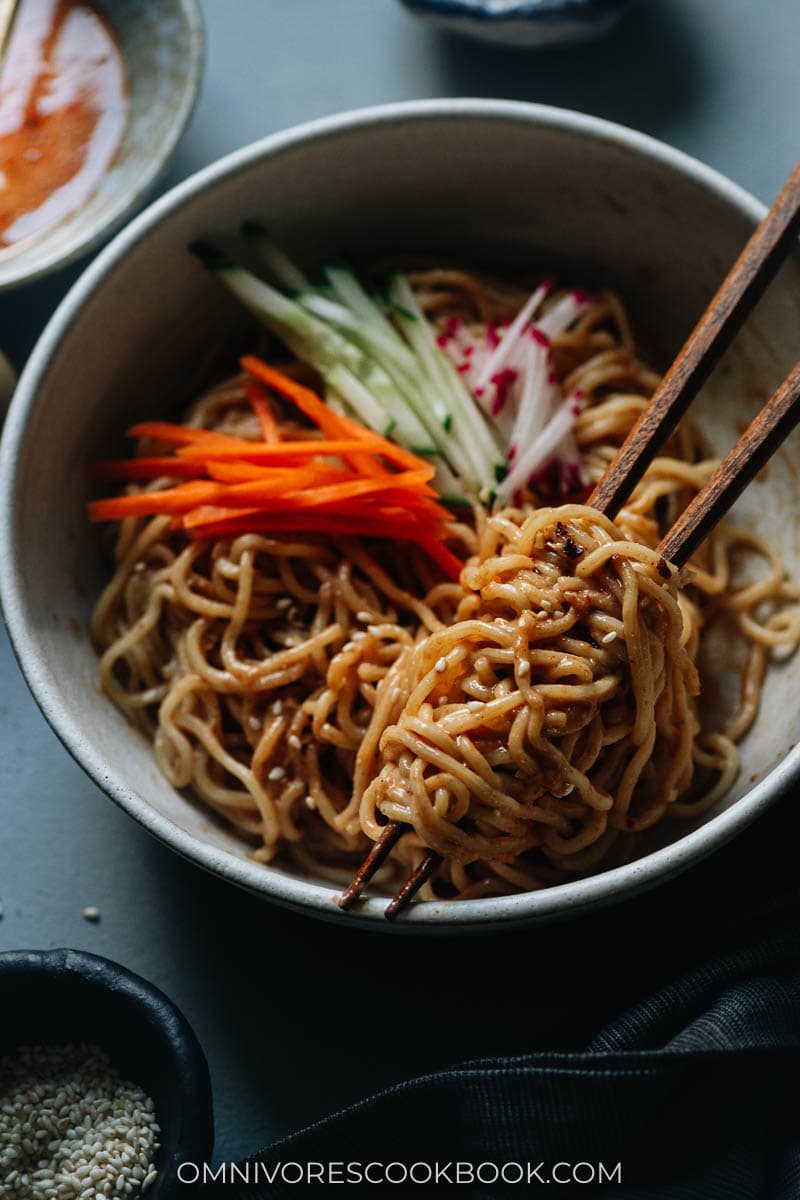
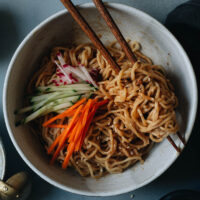
Real Deal Sesame Noodles
Ingredients
- 9 ounces (250 g) dried wheat noodles , or 1 pound (450 g) fresh wheat noodles (*Footnote 1)
Sauce
- 1/4 cup Chinese sesame paste (or unsalted natural peanut butter)
- 2 to 4 tablespoons warm water
- 2 tablespoons light soy sauce (or soy sauce)
- 2 tablespoons Chinkiang vinegar
- 1 tablespoon maple syrup (or sugar)
- 2 teaspoons homemade chili oil (or to taste) (*Footnote 2)
- 1 teaspoon sesame oil
- 1 teaspoon ginger , minced
- 2 cloves garlic , grated
- 1/8 teaspoon freshly ground Sichuan peppercorn powder
Topping options
- Cucumber , cut into thin strips (carrot and / or radish)
- Toasted sesame seeds for garnish
Instructions
- Add Chinese sesame paste to a medium size bowl and slowly add 2 tablespoons water, a little at a time. Stir with a spatula until the water is fully incorporated and it forms a smooth paste.
- One liquid ingredient at a time, add light soy sauce, Chinkiang vinegar, maple syrup, chili oil, and sesame oil, fully stir to incooperate each ingredient before adding the next one.
- Add the ginger, garlic, and Sichuan peppercorn powder. Stir to mix well. You can make the sauce ahead of time and store it in the fridge for 2 to 3 days.
- Boil noodles according to instructions. Transfer cooked noodles into a colander, rinse with tap water to stop the cooking. Drain well and transfer to small serving bowls.
- Serve the noodles with the sauce on the side with toppings of your preference.
- To eat, assemble your own bowl with any toppings you prefer, add a few spoonsful of the sauce. Mix and enjoy.
Notes
- The sauce in this dish is so flavorful and versatile that you can use many types of wheat noodles for a great result. For a traditional taste, try out lo mein noodles. Udon noodles and somen noodles work great as well.
- The homemade chili oil is usually served separately and added according to personal taste. I personally prefer to use a small amount in the sauce because it adds a very fragrant umami that makes the sauce stand out. Always ask your guests if they can handle a bit spiciness. If not, serve the chili oil separately with the noodles.
- The quantity of the sauce and noodle depend on many factors such as how many toppings you use, the type of noodles, and personal taste. The recipe is a good starting point that can general 2 big servings with some fresh produce toppings. Double the sauce if you plan on using more toppings.

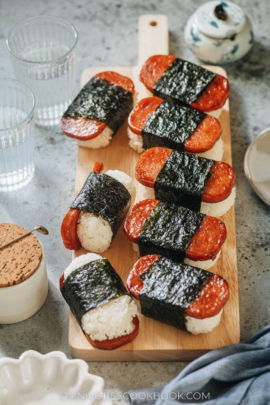
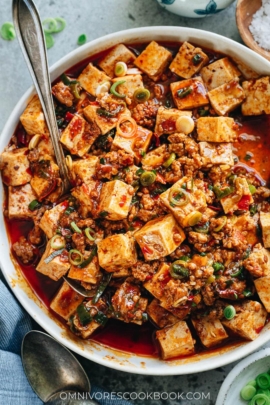

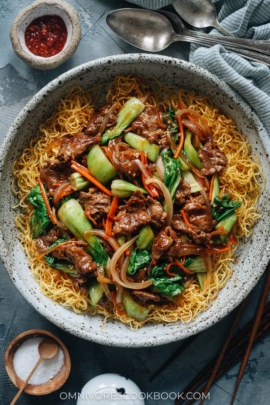
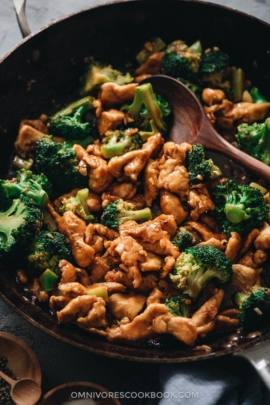
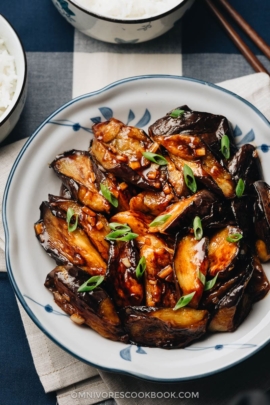






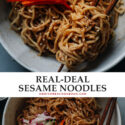
can’t wait to try some of these recipes!
I just subscribed to your newsletter and downloaded the cookbooks. Thanks for the recipes. I can’t wait to try some of them!
I just subscribed to your newsletter and cannot wait to start trying some of those recipes!
I dream about making recipes like this! Thank you very much Maggie – I can’t wait to give it a try!
I’m pretty sure I could eat my weight in these noodles, they look fantastic!
The flavors in this dish are making me crazy hungry, and I even have a little packet of Sichuan peppercorns!
I just subscribed to your newsletter and I am excited to try it out!
These sound so scrumptious and I hear ya about ingredients, but I’m different. The longer sometimes intrigues! 🙂
Hi Maggie, I was just looking for a recipe for this last week. Can’t wait to try it.
Happy cooking and hope the dish turns out great Kim!
What type of oil should i use when toasting peppercorns?
Any vegetable oil will be OK, such as peanut oil and grape seed oil.
Made this for dinner tonight and oh my gosh so delicious! And extremely satisfying! My hubby and I were both wanting to go back for seconds but so full we decided to save the rest for lunch tomorrow– and I’m already getting hungry just thinking about it! 😀
Thanks for the great recipe!
So happy to hear you cooked the recipe and enjoyed the dish! The leftover will taste even better 😉
Have a great week ahead Brittany!
I love the way you described Chinese cooking, Maggie. No wonder you have such a passion for it! I know I’ve never seen a more delectable looking noodle!
Maggie, these noodles look incredible. I’m always half afraid to come to your website because suddenly I’m SOOO hungry. 🙂 Making these this week…thanks for another inspiring recipe!
I have prepared this recipe and it is MARVELOUS…真棒!I also recommend homemade wide noodles that are thin—-I do mine with weight to get them right each time—-if 16 ounces of flour I use half of that minus one ounce meaning 7 ounces of water—-of course according to ambient temperature it could change—-key is a dry but not too dry of a dough—-let it rest—-when water is boiling add noodles—when boiling add the noodles—-when it comes back to a boil let it boil 15 seconds or so then add 1/2 cup of cold water—-when it gets close to returning to a boil strain them—-into a bowl with the sauce—-crispy fried ground pork—cucumber and cilantro….AND an ice cold BEER…… 🙂 Cheers—-
Hi Jack, I’m so happy to hear you tried out the recipe and liked it! Yes the sauce will go so great with homemade noodles. Thank you for sharing your noodle recipe! I’ll need to try that out next time. And yes, adding some ground pork and veggies, and beer, you’re good to go! 🙂
Have a great week ahead!
We love these sesame noodles. They are becoming a staple in our house. The pantry list is excellent very helpful shopping here in Beijing.
I’m glad to hear you tried out more recipes from my blog Cynthia! Yes this is a quick recipe and so delicious. I’m happy to hear my post helped you to gather ingredients in Beijing.
Happy cooking and hope your next project turns out delicious as well 🙂
This sauce sounds really incredible, Maggie. It has just the right number of ingredients, I think. Not too many, but enough to really make it something special.
HAPPY NEW YEAR!!
Thanks for your beautiful recipes! I wonder would it be OK to substitute Chinese sesame paste with tahini or it works better with peanut butter?
Hi Katya, it works better with peanut butter. Tahini tastes very different from the Chinese sesame paste and the result can be a bit strange.
Happy cooking and let me know how the dish turns out 🙂
Thank you!
Cannot wait to make this. It seems very much like a common street food dish in Shanxi called 面皮。 I’ve bought some sesame paste in preparation. What other dishes would go well with it if I wanted to serve it along with other Chinese dishes for a dinner?
Maggie,
When I lived in NYC, we lived to buy Cold Sesame noodles at a small Chinese joint in downtown Manhattan (Hwa Yuan on East Broadway). They were famous, and with good reason. They were delicious. Beyond, beyond delicious. I can’t tell you how many 1 AM taxi calls with eight of us students piled in there would descend upon this place and order the cold noodles and buy extra quarts to eat over the next few days. Ohhhh gawddd.
I am not alone in this memory. Here is the New York Times story about them: https://www.nytimes.com/2015/08/12/dining/cold-sesame-noodles-without-the-wait-for-takeout.html?_r=0.
They really were legendary. The New York Times has tried to replicate the recipe. Doesn’t do it for me. I have remembered that taste my entire life so far. The NYTimes recipe is really close, but no cigar.
I keep trying recipe after recipe to replicate it. Haven’t found it. I now think the difference is in the ingredients, like using Black Vinegar instead of any old Chinese vinegar. The right chili oil. Maybe honey instead of sugar? (but Hwa Yuan was a hole in the wall, they would have used the cheapest ingredients as standard restaurant fare).
However, I now have your recipe for chili oil, and I’ve ordered the chili flakes from Mala. Still to arrive (they’re out at the moment).
I am looking forward to making your version of this sauce. The Hwa Yuan noodles did not have sesame seeds, so maybe their family recipe excluded them. Doesn’t matter. That’s not where the taste was.
If it’s closer I’ll be back to tell you about it, and I will definitely let the New York Times know.
Thanks, Janie
P.S. They really were effing delicious and anyone who ate them remembers Hwa Yuan as heaven on earth.
Maggie, listen to this (it’s the first segment): http://www.wfuv.org/content/cityscape-new-york-noodle-story
Hi Janie, thanks for sharing the story of Hwa Yuan. I did a bit digging and here is what I found out.
The noodle uses: homemade egg noodles made with ice water, homemade collagen-rich chicken soup, a mixture of both sesame paste and peanut butter. (http://www.grubstreet.com/2016/09/family-of-nyc-chef-shorty-tang-opening-two-new-restaurants.html) I’m sure that a great chili oil and right type of vinegar is crucial as well.
I don’t think the restaurant would use honey. I use it to replace sugar simply because it dissolve into the sauce easier.
For me, the homemade chili oil is the key to make the noodle stand out. If you happen to have some homemade chicken stock, heat it until warm in microwave and use it to replace water when you mix the peanut butter and sesame paste. It adds another layer of umami.
Btw I just found out Hwa Yuan is permanently closed, and now the owner just opened another restaurant called Shorty Tang Noodle Shop. I’ll travel to NYC the next month and I’ll try to visit the store to try out the legendary noodles 🙂
Maggie, this recipe is fantastic! It was so delicious that I doubled the batch just to be sure there was enough sauce for dinner and lunch the next day. I’m glad I bought Chinese sesame paste. I have tried using peanut butter in the past (with other recipes), but results were always inconsistent (maybe the taste/texture of different peanut butters? idk). The only things I changed was I added maple syrup (ran out of honey) and I used chili flakes (not sure where my Sichuan peppercorns disappeared to). I used less than a 1/4 cup of water just because I liked the sauce a little thicker. Thank you for sharing your recipes! You make Chinese cooking so approachable and stress-free.
Hi Rekha, thanks so much for leaving a comment and I’m so happy to hear that you enjoy the dish! I think it’s totally fine to replace the honey with maple syrup. But I highly recommend you to try out the sauce with Sichuan peppercorns again the next time. I really love that numbing sensation 🙂
Hope you have a great week ahead and can’t wait to hear what you’ll cook the next!
Aloha Maggie
There is a Chinese noodle factory / store near my home. What kind of fresh noodle would you recommend that I order to make the Sesame noodle dish.
Can’t wait to try your recipe.
Colleen
This recipe is amazingly good! We make it with one part organic peanut butter and one part black sesame paste, and all other ingredients the same. Your recipe for chili oil is great on these noodles also. I’ve made it with lightly stir fried veggies, even kale! Keep up the great work!
These were great for a quick weeknight meal. I bought some fresh noodles from the asian grocery store and when I got home I realized that the instructions were in only in Korean! (I am Indian… lol) Luckily I guessed based off some numbers and pictures and it all came out great. Extra props to using my new julienne peeler for the garnish. Well worth it, and looks super professional for a home-cooked meal. I even had leftover sauce after feeding myself and my partner so I was able to whip up a quick meal a day later.
When I have had this dish on the mainland the carrots have been blanched and then rapidly cooled in an ice bath or running cold water.
This softens them, your recipe doesn’t really say whether or not to do so. This helps the carrots to mix into the noodles easier, and makes them easier to eat with chopsticks or fork as they’ll have a similar texture to the cucumber. i have also had this dish often mixed with ham strips also. Half peanut butter and half Tahini can also makes a more authentic flavor than just PB alone. IMHO.
Is there much difference between tahini and Chinese sesame paste?
The Chinese sesame paste uses toasted sesame seeds vs. tahini often use raw sesame seeds, so the un-toasted tahini usually has a grassy taste and different flavor profile. Although I heard there’s roasted tahini available (the type that has deep brown color) but so far I haven’t found them in regular grocery stores. I think the toasted tahini might taste very similar to Chinese sesame paste.
Fantastic recipe, thank you!
My first batch was made with cashew butter (peanut allergies in the house) and was pretty delicious, although not as good as later batches with the legit sesame paste. And although this recipe is really really good as-is, I find that adding 1-2T of shiro miso just brings the sauce to a whole ‘nother level. And although it’s not traditional, it bridges some of the flavor profile gaps between the high vinegar tanginess and the low savory nuttiness, making the overall dish taste more balanced and rounded if that makes any sense.
This is insanely tasty! One of our new favourites, especially for summer! Could eat it on a daily basis! Replaced the honey with agave and skipped Sichuan peppercorn powder, still so good! Thank you! 🙂
Would tahini be an acceptable replacement for sesame paste or peanut butter? This looks absolutely delicious and I can’t wait to try it. Thank you so much for the exceptional recipes you share with us.
You definitely can. The flavor will be different but the sauce should be very tasty!
I’m not sure why readers have to post that they want to try a recipe. I’m reading the comments to find out how they liked it, or what didn’t work or was especially good. Please consider posting AFTER you’ve tried the recipe!dd
I made this last night after shocking myself to find that my cupboard had every ingredient called listed. The only noodles I had around were linguine so said what the hay and used them. I made enough that I would have leftovers. Hah. I ate them all! Really good
I just made this and it is delicious! I had to make some substitutions: roasted sesame tahini, chili crisp instead of chili oil, a mixture of balsamic and rice vinegar. I also used coconut sugar. I’m eating it topped with grilled chicken thighs and cucumber. Yum!
These are the bomb! So delicious. Thanks!
Delicious! Going in our permanent rotation. We used peanut butter and Chili Garlic Sauce instead of Chili Oil. (I definitely WILL be making a batch of chili oil for next time) I usually do not care for peanut butter but in this capacity it is fantastic. I ended up adding more soy to my taste. Made one and a half batches of the sauce and it fed my family of five. For toppings we had thinly sliced blanched carrots, slivered cucumber, and cooked chopped chicken thighs. Perfect summer noodle dish!
This was great and tasted just like my favorite Szechuan place! I did make a few substitutions because of what I have on the cabinet, but will be making it again.
1)recipe had ingredients of sugar or Maple syrup, but instructions said honey. I used Maple syrup (pure, unsweetened) since it was the easiest to stir. Doesn’t taste like Maple at all, just gently sweet.
2) used peanut butter instead of sesame paste, black sesame seeds instead of white, and used red pepper flakes I stead of the chili oil. I will try and make the chili oil another time.
Topped it will chopped scallion, shredded carrots, and Napa cabbage.
3) used 6 oz noodles for sauce, so it was saucy.
It was great!
You may want to update your links to your Chili Oil, since the links on this page are 404, not found.
This might just be my new favourite thing to make, the sauce was so easy to whip up and was so amazingly creamy
That with the chilli oil -I used Chiu chow chilli oil, so extra flavour bomb- it was so satisfying
Thank you for sharing!
I made the noodles it is super easy & super Yummy.
Thanks so much.
These are delicious. I made extra sauce & it’s great for dipping veggies. Also put the chili oil on meat, grilled eggplant… so versatile. Thank you!
This recipe is so easy with flavor that is wow! I served with teriyaki sesame salmon!
Question : can the left over sauce be frozen for another day?
The sauce stays well in the fridge for a couple of days. If you want to store it longer, you can also freeze it.
Can’t wait to make this! Random question: what is the purpose is of adding the sauce ingredients slowly/one at a time? I’m new to Chinese cooking and I’ve made a couple noodle dishes similar to this, and I usually just pour them all in and then stir. Just curious 🙂
It just makes the sesame paste slightly easier to blend in the liquid and get a smooth texture. It is totally fine to pour everything in, but sometimes I found it might take a bit longer to mix and there might be small pieces of undissolved sesame paste floating around.
One of my favorites on the site. Used half half organic unsalted peanut butter and sesame paste from China which is available at 99 Ranch market in my locale.
Love this recipe